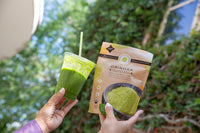Natural Hand Sanitizer DIY Tutorial
Having issues finding hand sanitizing wipes at your local store? We feel you! Trying to find cleaning products, in general, has become quite the challenge during the on-going pandemic. Now's a better time than ever to learn how to make your own natural hand sanitizer at home. Our DIY hand sanitizer features moringa oil because of its skin-safe antifungal properties. Besides that, did you also know moringa can help boost your immune system? Unlike methanol or wood alcohol, which was found in over 87 different hand sanitizers. "Methanol, or wood alcohol, is a substance that can be toxic when absorbed through the skin or ingested and can be life-threatening when ingested", cites the FDA's official announcement concerning the recall of toxic hand sanitizers. Yikes. Read on to learn how to make your own natural hand sanitizer, free of harsh chemicals.
DIY Hand Sanitizer
The key ingredient to making germ-killing disinfecting hand sanitizer is alcohol. Health experts and the World Health Organization recommend using alcohol with at least a 60% concentration of isopropyl alcohol when making your own disinfecting products. It's important to note that hand sanitizer is not as effective as washing your hands with soap and warm water for at least 30 seconds. Hand sanitizers with at least 60% alcohol should only be used as a last resort when you're unable to wash your hands.

What You Need to Make Hand Sanitizer at Home:
- Isopropyl alcohol, 60% concentration**
- If you're unable to find isopropyl (rubbing) alcohol, check out our notes below on substitutions
- Aloe vera gel, or vegetable glycerin
- You can use aloe vera straight from your own plant at home! Scroll down to learn how. Aloe vera gel is used to slow down how quickly the alcohol evaporates from your skin (and moisturizes it, too)
- Moringa oil (or your other favorite antibacterial essential oil)
- Moringa oil helps lock in moisture and naturally has antibacterial properties [1], making it a great choice to add. Alternatively, you can use tea tree, eucalyptus, clove, or peppermint essential oil.
- Air tight container with a spout or pump
- We recommend picking up a few travel-sized shampoo bottles commonly found at Walmart, CVS, Walgreens, etc.
- Combine 2 parts Isopropyl alcohol, with 1 part aloe vera gel in a bowl
- Add 4~6 drops of moringa oil
- Blend ingredients together thoroughly
- Transfer the gel into your container of choice using a funnel or a spoon
** Isopropyl (rubbing) alcohol substitutions:
Rubbing alcohol may be substituted with a high proof (95%) alcohol liquor such as Everclear. It is vital to keep in mind the percentage of alcohol concentration becomes diluted when you mix it with aloe vera or other ingredients.
How to Make Aloe Vera Gel at Home
1. Wash your hands thoroughly before getting started
2. Cut off an outer leaf from your aloe vera plant using a sharp pair of scissors or a knife
- Depending on the size of your plant, you made need to cut multiple leaves (2-3)
- Aim for leaves that are on the bottom of the plant
- For newer aloe plants, don't cut off too many leaves at once. This may send your aloe vera plant into shock and stunt its growth
3. Wash off your leaf(s) to remove dirt and drain the resin. Aloe vera resin is known to contain latex. Latex can cause irritation skin irritation.
- Sit the leaf(s) upright in a container with the cut side facing down
- Wait for 10~15 minutes for the yellow resin to drain out
4. Peel the skin from one side of the leaf
- Use a vegetable peeler or small knife
- Discard the skin
5. Scoop it up! Use a spoon to scoop out the translucent, sticky gel into container
- If you don't intend to immediately use the aloe gel, make sure to store in an airtight container and refrigerate
Staying Healthy
Miracle in the Green focuses on health and well-being above all else. Keep doing your part to keep you and your family safe! Please refer to government agencies such as the Centers for Disease Control and Prevention (CDC), WHO, and local authorities to stay up to date with the latest health and safety guidelines.
*Note: We are not medical doctors nor licensed medical professionals. We cannot give medical advice. This DIY recipe has not been lab-tested.
references:
- Pal, S K, et al. “Antimicrobial Action of the Leaf Extract of Moringa Oleifera Lam.” Ancient Science of Life, Medknow Publications & Media Pvt Ltd, Jan. 1995, www.ncbi.nlm.nih.gov/pmc/articles/PMC3331240/.
Love + miracles,


